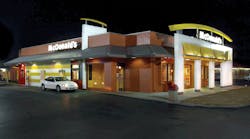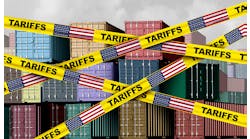Have you ever wondered how McDonald's does it? How is it that the Big Mac you crave is always the same in taste, appearance and quality whether that craving hits you in Arkansas, Alaska, Argentina or even Azerbaijan?
While the Big Mac's success is in large part due to its secret sauce, the real secret sauce of success from a logistics and supply chain perspective is the company's collaborative and innovative "System" that founder Ray Kroc set in motion nearly 60 years ago.
The notion of collaborative outsourcing and sharing value among all the elements of a national, and then global, enterprise was barely a blip on the business radar screen back then.
Kroc's principles—embodied in the structure of a "three-legged stool" and a philosophy that "none of us is as good as all of us"—revolutionized not only the fast food industry, but also established the cooperative template for modern supply chain operations and effective relationships between companies, their franchises and their consumers.
It's also an inspiring and revelatory story that's featured in a new book, Vested: How P&G, McDonald's and Microsoft are Redefining Winning in Business Relationships. The company adopted inherently vested principles and mindsets well before the Vested movement took shape. More on that later.
Three-Legged Stool
McDonald's success is found within the long-term transparent relationships based on a firm belief that everyone in the McDonald's "System" can and should win. The ingrained culture for long-term, win-win relationships with suppliers dates back to McDonald's inception, when Kroc established a precedent of trust and loyalty. Kroc believed that if the restaurant owner/operators and suppliers were successful, success would come to him as well.
To this day, Kroc's "System" philosophy is described as a three-legged stool. One of the legs is McDonald's employees, a second leg is the owner/operators that run the restaurants, and the third leg is McDonald's supplier partners. Of course this type of stool is only as strong as the three legs. If one leg fails, the entire structure is weakened or can fail. Company employees, franchise owner/operators and suppliers each support the weight of McDonald's equally. For one to prosper, each must prosper.
Kroc's System has stood the test of time because leaders within the System have continued to honor this "System First" approach where solutions always answer the question, "What's best for the System?"
Vested's Five Rules
Developed and codified by University of Tennessee research and fieldwork, the Five Rules provide a conceptual framework for collaborative, win-win outsourcing and business relationships. The McDonald's model is an excellent real-life illustration of how the rules operate.
Here's how the Vested rules work in the McDonald's framework.
Rule 1: Focus on Outcomes, Not Transactions
McDonald's consciously avoids transaction-based relationships. It insists that suppliers have long-term relationships that drive value and achieve McDonald's key business outcomes. The way this works is that McDonald's and its most strategic suppliers have a deep commitment to each other to continually deliver value for McDonald's System. Suppliers are confident the McDonald's business is not vulnerable to competitors' price-cutting and arbitrary changes.
"The trust and confidence in the future means we shift a majority of our resources to driving innovation, quality, supply chain optimization, and investing in future growth initiatives. This takes trust on both sides of the table, but once established, it creates leverage vs. the traditional arm's length RFP type approach," says Pete Richter, president, Global McDonald's Business Unit for Cargill and chair of the United States Supplier Advisory Council.
Rule 2: Focus on the What, Not the How
A key element is to know everyone's core competencies. Kroc had the vision, but knew he needed to rely on the suppliers and restaurant owner/operators for implementation. When it came to suppliers, Kroc – and later Fred Turner – took the helm by setting the standards for the famed QSC&V (Quality, Service, Cleanliness & Value). At the same time it trusted its suppliers would determine "how" to best meet McDonald's exacting standards.
Suppliers consistently report that while McDonald's is very much involved in the supply chain, it avoids micromanagement. Innovations to reduce costs, improve service, or even create new products for the menu are commonplace among McDonald's suppliers.
"McDonald's relies on us to constantly question how we can do things better for the System," explains Ed Sanchez, CEO and chairman of Lopez Foods. "In today's environment, sustainability and cost reductions are very important to McDonald's."
Rule 3: Agree on Clearly Defined and Measurable Outcomes
While food safety and quality is at the top of what McDonald's measures with suppliers, it's only part of the picture. In 2004, McDonald's Senior Leadership team led an effort to revitalize McDonald's core business objectives and create "Plan to Win." The Plan to Win strategic blueprint helps all parties in the System focus on the core drivers of McDonald's business. The objective is to keep the McDonald's brand relevant and meet the evolving needs of consumers. It concentrates on being better, not just bigger, while providing a common framework for global business and allowing for local adaptation.
The Supplier Performance Index is an example. It's an in-depth evaluation tool used by McDonald's and its suppliers to assess success levels. Typically, the SPI covers six categories – management, system first, assured supply, quality systems, innovation, and predictable competitive pricing. The scores are secondary to the conversation that is engendered. The SPI leads to insight, calibration, alignment and benchmarking.
Rule 4: Pricing Model/Incentives for Cost/Service Trade-Offs
Pricing embodies the three-legged stool concept. McDonald's, store owner/operators and suppliers each must secure a profitable, long term financial picture – one that keeps the company first and, as such, secures stable futures for all.
Pricing protocols must therefore be highly transparent in nature and contain the variables to help all parties understand the business. The goal is optimization across the System. The protocols were developed to help show tradeoffs on the total costs. Shifting suppliers can save a penny, but the finished goods could end up costing more based on location and transportation. The goal of McDonald's pricing protocols is to reduce the total cost—not the price. It is a transparent approach that works with suppliers to dig into the overall cost structures while preserving supplier margins.
Pricing disputes are rare. It is McDonald's commitment and long term view that makes suppliers comfortable about not fighting over a penny when they know there is likely a nickel in the future. Simply put, it is neither in McDonald's nor the suppliers' best interest to focus on the lowest price or the natural short-term fluctuations in the market.
Rule 5: Governance with Insight, not Merely Oversight
The McDonald's System is in the insight camp, following the basic idea of establishing a flexible operational framework that allows partners the freedom and the incentives to do what they do best to achieve the win-win.
McDonald's outsourced supply chain model gives its suppliers important seats at the table. Those seats come with the expectation that a competitive advantage for McDonald's will result.
The System is based on the governing principle of long-term wealth and competitive advantage by mitigating costs, anticipating and then preventing safety issues, and producing quality and innovative products. The result is increased customer value, better brand health and stronger business performance.
A Handshake Seals Deals
Kroc established a precedent of trust, loyalty and fairness with suppliers that motivates them to invest in McDonald's business—creating a marketplace advantage in key business drivers such as cleanliness, quality, value, assured supply, safety, and being better, not merely bigger.
Especially surprising—and somewhat dumbfounding in today's complex global relationships—is that McDonald's suppliers invest in McDonald's business without formal contracts. McDonald's does business with strategic suppliers based on the commitment of the old-fashioned handshake. Kroc believed that as long as both McDonald's and the suppliers stay loyal to their long-term "System First" thinking, a handshake was all that was needed. The flexibility of a handshake agreement to committed principles rather than detailed service level agreements (SLAs) allows McDonald's to address changes in the market and business needs as they occur.
"What's In It for We (WIIFWe)" thinking among McDonald's, its owner/operators, and their suppliers created a system that was recently named by Gartner as the third best supply chain. The trust in the System inspires collaboration that is unparalleled in other supplier relationships. It's based on collaborative outsourcing and creating and sharing value.
Kate Vitasek is a faculty member of the University of Tennessee's Center for Executive Education. Karl Manrodt is a professor at Georgia Southern University. Joseph Tillman is a senior researcher for Supply Chain Visions, Ltd.



